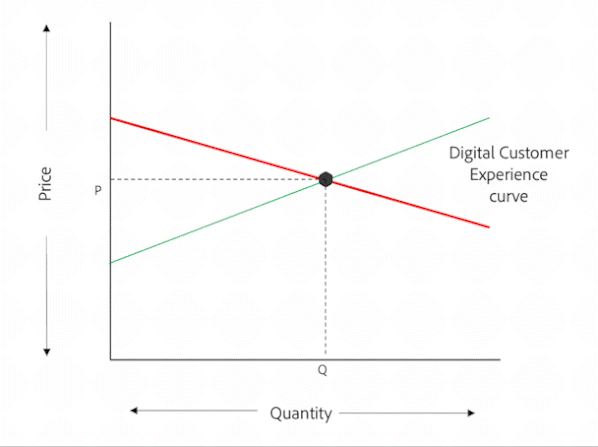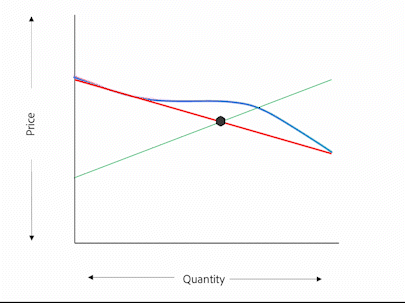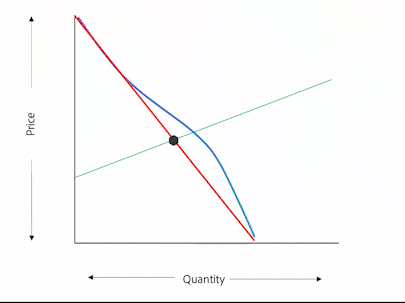In the previous article I introduced the concept of Digital Customer Experience elasticity and argued that the impact of Digital Customer Experiences on demand (quantity) is a S-curve. In this article, I will further elaborate on Digital Customer Experience elasticity in the context of elastic and inelastic products and services. Before you continue, I highly recommend revisiting this article first.
Digital Customer Experiences takes place throughout many digital interactions relevant to a core service or product offering, including multiple moments of truth that influence customer outcomes.The development of Digital Customer Experience strategies faces a number of challenges. First, there is no universally scope and how it relates to associated initiatives, such as quality and satisfaction. Second, it is widely accepted that Digital Customer Experiences are very context-specific and that there is unlikely to be a generally applicable ‘play book’ appropriate across all industries and company strategies.
One thing we know, customers and consumers are changing. In the field of Digital and Customer Experience, we are often told that price is less important to some customers than experience and that customers may put up with more friction during their customer journey if they are invested in your brand. You could argue that the strength of your brand, and the degree to which customers will put up with a ‘bad’ experience will determine the elasticity.
Elastic and Inelastic products/services
Supply and demand determine the price of products and services. Organizations study the rise and fall of demand to predict market trends, set prices for their products and design marketing or sales strategy. Knowing about the elasticity of demand is crucial to understanding business and the economy.
Elasticity of demand refers to the change in demand when a change in another economic factor, such as price or income occur. Demand is a feature of economics that refers to consumer willingness or desire to purchase a product or service. Predicting demand has many factors, including price, availability, and exclusivity. Additional variations occur between target markets with different behaviours and dynamics. There are two main classifications of demand, elastic and inelastic.
Elastic goods are often more comfort or luxury products like a car, furniture or going to the restaurant or traveling. For elastic goods, it means that a small change in the price of the product may lead to a greater change in the quantity demanded by the consumers.
Goods for need or necessities are the products that have inelastic demand, water, salt, soap, petrol, etc. or the items that have no close substitutes like medicines. When the demand for the given product is inelastic then no matter what the price is, people will not stop buying it.
See the infographic on the bottom of the page for more details about elastic and inelastic demand. In this article I link elastic and inelastic more to industries and product groups. Bare in mind that within one industry, e.g. retail, there are both elastic and inelastic product groups. Coca-cola for instance is often seen as a elastic good.
Price determination
The price of a product or service is determined by the interaction of supply and demand in a market. The resulting price is referred to as theequilibrium priceand represents an agreement between organizations and consumers of the product or service. In equilibrium the quantity of a product supplied equals the quantity demanded by consumers.
The logic of the model of demand and supply is simple. The demand curve shows the quantities of a particular good or service that consumers will be willing and able to purchase at each price during a specified period. The supply curve shows the quantities that organizations will offer for sale at each price during that same period. By putting the two curves together, we should be able to find a price at which the quantity consumers are willing and able to purchase equals the quantity organizations will offer for sale.
The impact of Digital Customer Experience on quantity and price for Elastic products

Demand and Supply
The demand curve of elastic products and service is shallow because a small change in price results in a substantial change of quantity demanded. See above the demand and supply curve and the dot for the equilibrium price (or market equilibrium).
In the previous article I introduced the Digital Customer Experience (DCX) curve as a S-curve (sigmoid function). This curve plots the degree of DCX against the impact it has on quantity. When adding the DCX curve to the principle of supply and demand, the following image arises (see below)

Digital Customer Experience Elasticity S curve
To identify the impact of DCX on both price and quantity, I extend the lines of the equilibrium price (Q and P) and arrive at the following image.

Impact Digital Customer Experience on demand and price on Elastic Products
Digital Customer Experiences has impact on price (from P to P1) and substantial impact on quantity (from Q to Q1) for goods and services which are elastic.
The impact of Digital Customer Experience on quantity and price for Inelastic products
Inelastic demand for a product or service is when any significant change in the product’s price does not result in any appreciable difference in the demand for the product. Such a scenario is observed when few or very few good substitutes for the product exists. The price elasticity of demand for the inelastic product is less than one as the percentage change in demand is less than the percentage change in price. But what will happen if we add the Digital Customer Experience into the equation.
Applying the same principles, the following image arises. Notice the difference between the quantity demanded with the elastic demand curve.

Impact Digital Customer Experience on demand and price on Inelastic Products
Digital Customer Experiences CX has impact on price (from P to P1) and less impact on quantity (from Q to Q1) for goods and services which are in inelastic compared to elastic demand.
Discussion
In the economics of supply and demand we know that when either the demand or the supply curve shifts, the results are unambiguous. We know what will happen to both equilibrium price and equilibrium quantity as we know whether demand or supply increased or decreased. But as I argue in this article, it is not just price that has impact on demand.
As mentioned earlier, literature suggests that Digital Customer Experiences can lead to greater customer loyalty and secure future revenues (Fornell, 1992; Rust et al., 1994). Better Digital Customer Experiences could potentially reduce the cost of future customer transactions, new customer acquisition, decrease price elasticity of demand and minimize the likelihood that customers will defect if quality falters (see Anderson et al., 1994). Other scholars like Vargo and Lusch (2004) contrast this with traditional ‘goods dominant logic that sees value arising from economic exchange – value is measured by the price paid.
In my previous article, I introduced Digital Customer Experience elasticity and argued that sooner or later Digital Customer Experience will reach a period of stagnation, no matter how successful the experiences have been on demand before.In this article I argue that there is a difference between impact of Digital Customer Experience on quantity and price for Elastic and Inelastic products(keeping all other parameters the same).
My next article will go one step further and more in depth. What does it mean when your organization is at risk and having head winds. Or the opposite, what does this mean when your organization is at growth. Will Digital Customer Experience still has impact? Stay tuned and follow me on LinkedIN to get notified when my new article is published.
References
Anderson, E.W, C. Fornell and D.R.Lehmann. 1994. Customer satisfaction, market share, and profitability. Journal of Marketing, 56, July, 53-66.
Fornell, C. 1992. A national customer satisfaction barometer: The Swedish experience. Journal of Marketing, January, 1-21.
Rust, R.T., A.J. Zahorik, and T.L.Keiningham. 1994. Return on quality: Measuring the financial impact of your company’s quest for quality. Probus, Chicago.
Vargo,S & Lusch,R .(2004). Evolving to a new dominant logic for marketing. Journal of Marketing,68, 1,pp. 1–17
Infographic Elastic demand vs Inelastic demandhttps://www.wallstreetmojo.com/elastic-vs-inelastic-demand/
